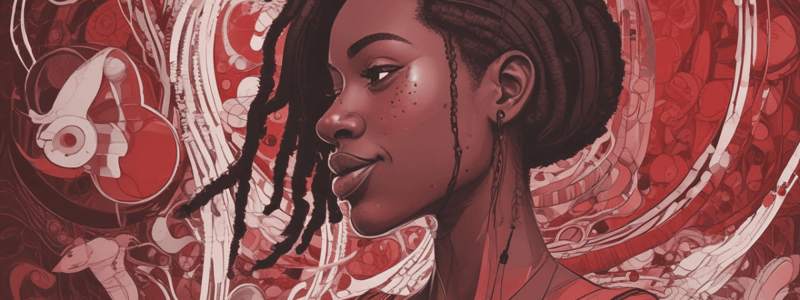Podcast
Questions and Answers
What are the common symptoms of anemia in sickle cell anemia patients?
What are the common symptoms of anemia in sickle cell anemia patients?
Pale skin, weakness, fatigue, and shortness of breath
What is the genetic basis of sickle cell anemia?
What is the genetic basis of sickle cell anemia?
Mutation in the HBB gene that codes for hemoglobin subunit beta
What is the purpose of newborn screening for sickle cell anemia?
What is the purpose of newborn screening for sickle cell anemia?
To diagnose and manage the disease early in life
What is the primary goal of pain management in sickle cell anemia?
What is the primary goal of pain management in sickle cell anemia?
What is the role of folic acid supplements in sickle cell anemia management?
What is the role of folic acid supplements in sickle cell anemia management?
What is the curative treatment for sickle cell anemia?
What is the curative treatment for sickle cell anemia?
What is a common complication of sickle cell anemia?
What is a common complication of sickle cell anemia?
Why are sickle cell anemia patients at increased risk of kidney damage?
Why are sickle cell anemia patients at increased risk of kidney damage?
What is the purpose of hemoglobin electrophoresis in sickle cell anemia diagnosis?
What is the purpose of hemoglobin electrophoresis in sickle cell anemia diagnosis?
What is the significance of peripheral blood smear in sickle cell anemia diagnosis?
What is the significance of peripheral blood smear in sickle cell anemia diagnosis?
Flashcards are hidden until you start studying
Study Notes
Symptoms
- Anemia: pale skin, weakness, fatigue, shortness of breath
- Pain episodes (crises): acute, severe, and recurring pain in abdomen, chest, joints, or bones
- Increased infections: pneumonia, meningitis, osteomyelitis
- Delayed growth and development in children
- Vision problems: retinopathy, blindness
- Ulcers: painful sores on legs
- Jaundice: yellowing of skin and eyes
- Dark urine: increased bilirubin levels
Genetics
- Autosomal recessive disorder: inherited from parents
- Mutation in HBB gene: codes for hemoglobin subunit beta
- HbS gene: abnormal hemoglobin that causes sickling of red blood cells
- Carrier frequency: 1 in 12 African Americans, 1 in 100 Hispanics, 1 in 500 Caucasians
- Inheritance patterns:
- Two copies of HbS gene: sickle cell anemia
- One copy of HbS gene: sickle cell trait (carrier)
- No copies of HbS gene: no sickle cell anemia or trait
Diagnosis
- Newborn screening: mandatory in many countries
- Hemoglobin electrophoresis: separates hemoglobin types
- High-performance liquid chromatography (HPLC): measures hemoglobin levels
- Molecular genetic testing: detects HBB gene mutations
- Peripheral blood smear: examines red blood cell shape
Treatment Options
- Pain management: medication, hydration, oxygen therapy
- Antibiotics: prevent and treat infections
- Folic acid supplements: prevent anemia
- Blood transfusions: increase red blood cell count
- Hydroxyurea: reduces frequency of pain episodes
- Bone marrow transplant: curative treatment, rare
Complications
- Acute chest syndrome: respiratory failure
- Stroke: increased risk in children
- Pulmonary hypertension: high blood pressure in lungs
- Kidney damage: increased risk of kidney failure
- Gallstones: increased bilirubin levels
- Priapism: painful, prolonged erection
- Increased risk of infections: pneumonia, meningitis, osteomyelitis
Symptoms
- Pale skin, weakness, fatigue, and shortness of breath are symptoms of anemia
- Acute, severe, and recurring pain in abdomen, chest, joints, or bones occurs during pain episodes (crises)
- Increased risk of infections, such as pneumonia, meningitis, and osteomyelitis
- Delayed growth and development are common in children with sickle cell anemia
- Vision problems include retinopathy and blindness
- Painful sores on legs are a common symptom of ulcers
- Yellowing of skin and eyes (jaundice) and dark urine are signs of increased bilirubin levels
Genetics
- Sickle cell anemia is an autosomal recessive disorder, inherited from parents
- A mutation in the HBB gene, which codes for hemoglobin subunit beta, causes the condition
- The HbS gene leads to abnormal hemoglobin production, causing sickling of red blood cells
- Carrier frequency varies among populations: 1 in 12 African Americans, 1 in 100 Hispanics, and 1 in 500 Caucasians
- Inheritance patterns determine the likelihood of developing sickle cell anemia or being a carrier
Diagnosis
- Newborn screening is mandatory in many countries to detect sickle cell anemia
- Hemoglobin electrophoresis separates hemoglobin types to identify abnormal hemoglobin
- High-performance liquid chromatography (HPLC) measures hemoglobin levels
- Molecular genetic testing detects HBB gene mutations
- Peripheral blood smear examines red blood cell shape to identify sickling
Treatment Options
- Pain management involves medication, hydration, and oxygen therapy
- Antibiotics are used to prevent and treat infections
- Folic acid supplements prevent anemia
- Blood transfusions increase red blood cell count
- Hydroxyurea reduces the frequency of pain episodes
- Bone marrow transplant is a curative treatment, but rare
Complications
- Acute chest syndrome is a respiratory failure complication
- Children are at increased risk of stroke
- Pulmonary hypertension leads to high blood pressure in lungs
- Kidney damage increases the risk of kidney failure
- Gallstones are a common complication due to increased bilirubin levels
- Priapism is a painful, prolonged erection that can occur
- Increased risk of infections, such as pneumonia, meningitis, and osteomyelitis, is a common complication
Studying That Suits You
Use AI to generate personalized quizzes and flashcards to suit your learning preferences.



